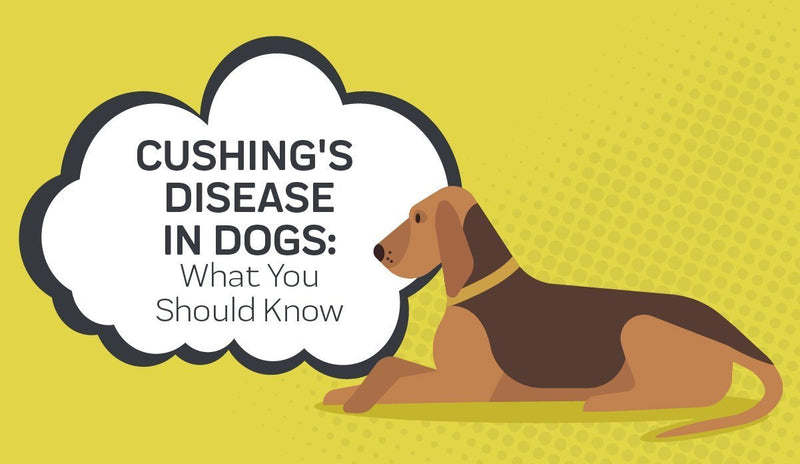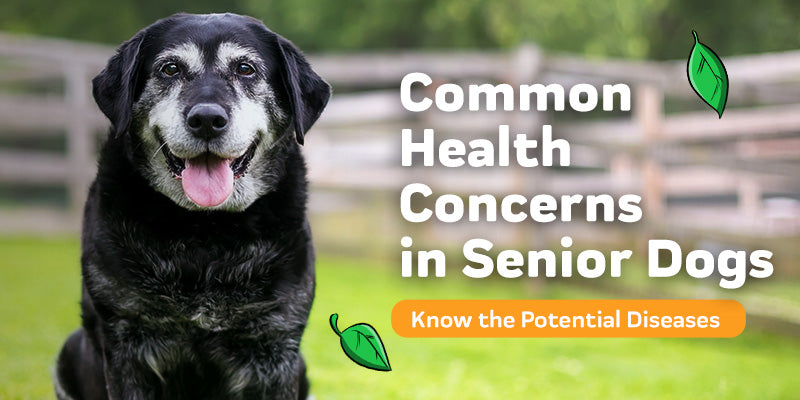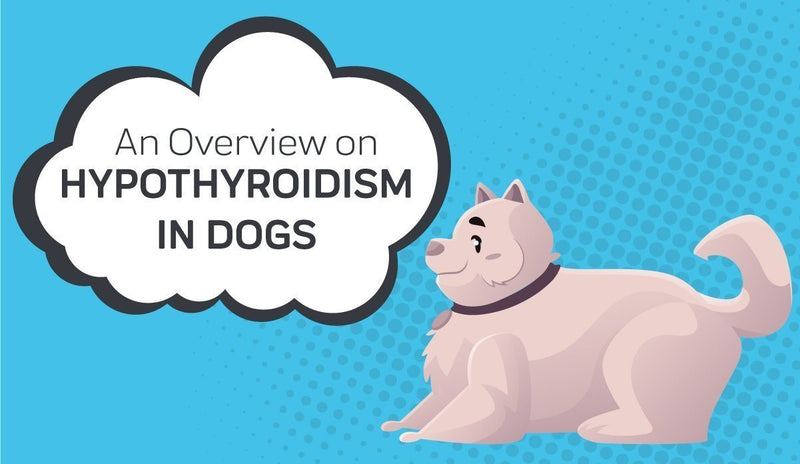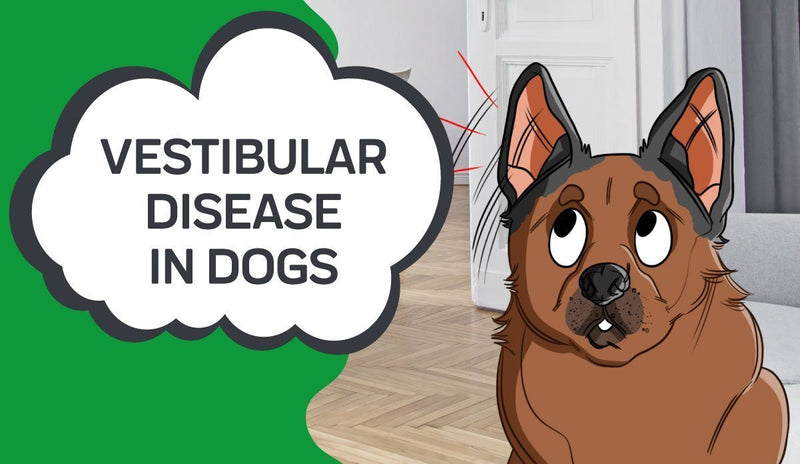
Many are aware that Cushing's Disease in humans is a relatively well-known thing. However, some may wonder what Cushing's Disease in dogs is. Unfortunately, in many cases, it can go unnoticed, which is why it's important to be aware of this illness!
Typically, Cushing's Disease for dogs is recognized by adrenal glands that have become hyperactive. Consequently, it can have some nasty effects for your pooch. Having an understanding of what Cushing's in dogs is, what symptoms to look for and the potential treatments can give your pet a better chance of living a happy, healthy life.
TABLE OF CONTENTS
1. What Is Cushing's Disease?
2. The Role Of ACTH
3. Understanding Pituitary Adenoma
4. Important Things To Know
5. Cushing's Disease Causes
6. Symptoms Of Cushing's Disease In Dogs
7. How Vets Diagnose Cushing's Disease
8. Cushing's Disease Treatment
9. Are There Cures For Cushing's?
10. How Can CBD Help?
11. Cushing's Disease In Dogs: A Final Thought
What Is Cushing's Disease?
To put it simply, Cushing's Disease occurs when the dog's body begins to create levels of cortisol that are higher than the body can handle. Typically, the hormone cortisol is made by the adrenal glands, which is why the illness can often be called hyperadrenocorticism.
When there is too much cortisol in the body, issues can show up. When the adrenal glands are working normally, they do a number of things like handling stress, regulating metabolism, blood glucose, and blood pressure. As you can imagine, when these things lose their balance, a lot can go wrong in the body very quickly. Some may also refer to it as Cushing Syndrome in dogs.
The Role Of ACTH
Typically, when the cortisol hormone is released, it's in response to another hormone known as ACTH. ACTH is created by the pituitary gland and releases when blood sugar is low or when other external stressors take place. As a result, more cortisol is created, which heightens the blood sugar levels by changing proteins and fat into glucose. Consequently, issues with the pituitary glands can also effect the adrenal glands and their creation of cortisol.
ACTH tests can help vets to diagnose issues with the adrenal glands. If the ACTH is added, and the cortisol response is much higher or lower than normal, it can signify problems with the glands. Essentially, the test requires an ACTH injection followed by taking blood.
Understanding Pituitary Adenoma
Adenomas are tumors that can form on the pituitary glands. They are typically benign, but they can have an effect on how functional those glands are. When adenomas are functioning, they are able to still create ACTH. When they are non-functioning, that hormone isn't created.
However, the non-functioning adenoma can cause a build-up of pressure in the surrounding area. It's also important to remember that there can be heightened levels of ACTH in the body when the adenoma is functioning and the glands are creating the hormone as well.
As a result, there's a lot of extra cortisol floating around, which is often the primary cause of Cushing's Disease in dogs.
Important Things To Know
There are a few things worth keeping in mind when it comes to Cushing's Disease in dogs. The first is that it's highly treatable once your vet has diagnosed the issue. Furthermore, keep in mind that canines with Cushing's Disease can still have a decent lift expectancy.
Furthermore, there are a lot of symptoms that can come with this disease, so anything that seems odd should warrant a trip to the vet. It's also typically an issue that occurs in older dogs rather than younger ones.
While it can be mixed up with Addison's Disease because these are diseases that can mimic Cushing's signs, Cushing's is actually on the opposite end of the spectrum.
Finally, breeds that are more susceptible to this issue are:
- Boston terriers
- Australian shepherds
- Labrador retrievers
- Yorkshire terriers
Keep in mind that dogs of any breed, size, gender, or age can develop Cushing's Disease. Make sure that you keep an eye out for the signs and contact your vet if you notice your dog behaving abnormally. That way, any issues can be resolved quickly.
Cushing's Disease Causes
When it comes to what causes Cushing's Disease, there are two situations that unfold with this illness. The most common is a type considered to be pituitary-dependent.
As we've discussed, this includes the presence of a pituitary adenoma. This type of Cushing's disease usually makes up around 80% of all cases. On the other hand, the remaining 20% often results from tumors that have occurred in the adrenal gland.
In most cases, medication can keep pituitary adenomas under control pretty well. However, in some cases, they can become macroadenomas, which are those that have grown larger than 1cm in size. Because of this growth, they can place a lot of pressure on the surrounding tissues.
About 15% of pituitary adenomas become macroadenomas, which can add other neurological symptoms due to the size on top of the Cushing's symptoms. In these cases, the prognosis can become much less bright. It's in these most extreme cases that you'll want to work with your vet to keep your dog happy and comfortable for as long as possible and knowing when you might need to put a dog down with Cushing's Disease. Luckily, those are very uncommon circumstances.
The good news is that benign macroadenomas can be removed through surgical means, which can provide a great solution. Malignant tumors can also be removed, but tend to have a lot more complications.
For the most part, handling dogs and Cushing's Disease can be quite manageable with the use of surgery and medication.
Symptoms Of Cushing's Disease In Dogs
Ultimately, tests will need to be performed in order to determine if your dog has Cushing's disease, but there are some symptoms that can help to signify what might be going on.
Cushing Disease in dogs symptoms can include:
- Heightened thirst
- Hair loss
- High amounts of urination
- An appearance of being pot-bellied
- Skin-thinning
- Dry skin
- Heightened appetite
- Compromised immune system
- Urinary accidents
- Obesity
- Lethargy
- Frequent bruising
- Scaly patches on various areas
In some cases, you may notice many symptoms, while in others you may only see one or two. Keeping an eye out for them is key! Even if they don't signify the presence of Cushing's in dogs, they can be signs of other issues going on that likely need to be addressed. You really can't go wrong with getting your pet checked out when you notice signs like excessive thirst in dogs or urinary accidents.
How Vets Diagnose Cushing's Disease
When you notice any of the signs of Cushing's in dogs mentioned earlier and get your dog to the vet, they will then need to check your pet out and run some tests to get to the root of the issue. Here, we'll discuss some of those tests.
Tests Included
For the Cushing's Syndrome diagnosis, the tests your vet will conduct can be incredibly helpful because the symptoms can be very similar to other diseases, such as Addison's disease and diabetes. However, Cushing's and Addison's effect on the body quite differently. Consequently, it's important that tests for serum biochemistry, cell counts, and others are extremely helpful.
When the situation is narrowed down, a low-dose dexamethasone suppression test can be key for diagnosing Cushing's Syndrome in dogs. Like the ATCH test, this test will show differences in the cortisol levels found in your dog's blood. A normal response includes a decrease in cortisol, while a test positive for Cushing's will show no difference.
In some cases, sinus sampling can also be a method used for diagnosing Cushing's in dogs. However, this is a more invasive option. Both of the tests listed here are quite reliable, so you'll be able to trust that a diagnosis of Cushing's is very accurate.
Cushing's Disease Treatment
One of the first things pet owners are likely to wonder is how long their dog can live with Cushing's Disease, or whether or not their dog is in pain.
While there are no cures for Cushing's Disease in canines, there are management options that can help your dog to live a long, happy life. After your furry friend has been diagnosed, your vet can help you find the best path!
If you want to cover all your bases, it can also be very helpful to ask your vet about the recommended diet for canines with Cushing's Disease.
Medications commonly used for Cushing's Disease are:
Typical Prognosis Information
Generally speaking, your dog can absolutely still live a long, happy life with this illness. This prognosis only really changes when there is a large tumor present or a malignant one. Neither of these illnesses is a very common occurrence.
Looking After Dogs With Cushing's
Canine Cushing's Disease isn't something that can typically be prevented, so don't beat yourself up if you discover your dog has it. Furthermore, in most cases it doesn't cause any major problems with regard to the quality of life your dog has. In most situations, medications that include trilostane vetoryl are used for this disease, and assist in regulating the illness. You may want to take a look at vetoryl side effects, to gain a deeper understanding of this medication.
The sooner you catch the signs and get your canine companion to the vet, the better off they'll be. With early medications and treatment, it shouldn't cause your dog too many issues. With the right care, your dog will be back to romping around happily before you know it.
It's not worthwhile to allow a dog with Cushing's Disease to go untreated. As you can imagine, the Cushing Symptoms in your dog can become a lot worse, and result in a lower life expectancy.
Are There Cures For Cushing's?
Currently, there are no known cures for Cushing's Disease in dogs, but it can be managed through the use of medication, and in some cases surgery. The sooner you catch the symptoms of Cushing's in dogs and have your dog diagnosed, the easier it will be to get your dog back into decent health. As with any other illness, it's important to have a good understanding of how your dog behaves normally, so that you can catch any small changes that may indicate the beginning of Cushing's Syndrome.
How Can CBD Help?
While CBD may not be a cure-all for diseases like Cushing's, it can be an option to help with soothing pain and assisting your dog's health overall. It's a fantastic supplement that you can use whether your dog is healthy or needs a little help. It's also a fully natural option.
If you'd like to use CBD to help your dog, it can be a good idea to check with your vet, just to make sure it's okay. Although it doesn't tend to have any side effects for you to worry about, it's always a good idea to check, because every dog is a little bit different.
CBD Oil

For those who are interested in ease of use, Innovet Pet's CBD Oil is a great option. This fully organic option is tested and proven to be safe for your pet. It's made to provide them with the benefits they need, without any negative effects. It doesn't contain any THC, so there won't be any “high” that your dog experiences.
Instead, they'll receive benefits that can assist them with joint and digestion help as well as help with anxiety and stress. Furthermore, it's a supplement, meaning that you'll be able to provide it to your dog even if they are completely healthy. Through the use of the dropper, you'll also be able to have complete control over the doses.
CBD treats are also a fantastic choice that can make your life, and your dog's, a whole lot easier. As far as they know, they're getting a delicious treat and you get the peace of mind in knowing that they're getting some health benefits from it. Just like the CBD oil, these treats are natural, organic, and free from THC, so they're perfectly safe for your dog.
Cushing's Disease In Dogs: A Final Thought
When you want to make giving a supplement to your dog even easier, these soft chews are delicious, safe, and easy to dose out however you'd like. Keep in mind that with any new CBD product, it's best to start with a very small amount and gradually increase the dose to whatever is recommended for your dog. That way, they don't overdo it when they're suddenly feeling great!
Now, you have a better idea of what Cushing's is, and how to pick out the Cushing's Disease Symptoms in dogs when they show up.
It's not always easy to tell when your dog isn't feeling well. Sometimes, an illness can become quite bad before you realize something is wrong.
In most cases, this is because our pets are fantastic at hiding pain. Unlike humans, they can't really tell us when something is uncomfortable. Because of this, it's so important to make sure you can tell when they're behaving a little bit differently.
On top of that, getting your dog to the vet as soon as you notice any abnormalities is going to allow the vet to make a diagnosis a lot sooner, typically resulting in a much better prognosis for your furry family member. Don't forget that in the majority of cases, Cushing's Disease is very manageable.
We know how hard it can be to receive a diagnosis like Cushing's for your pet. However, they still have a good chance of living a happy, long life as long as the disease is managed well. For dogs, Cushing's Disease is certainly not a death sentence in the vast majority of cases, and you have options for helping your dog to keep living happily!
Sources:
CBD: Safety and Side EffectsCBD Decreases Anxiety And Depression
CBD May Help With Treating Pain


















Hello Linda,
Thank you for sharing your experience with Innovet. I’m sorry to hear of your dog’s condition and that it sounds like she is exhibiting symptoms similar to her mother.
13 yr old Yorkshire terrier. Showing same symptoms as her mother did. Blind in one eye, watery lump under her chin, Heavy panting, constant hunger which starts mostly at sundown. Pot belly, lethargic most of the day.